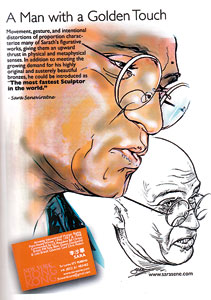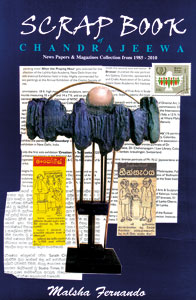What a way to record the achievements of a creative genius, I thought as I glanced through 'Scrap Book of Chandrajeewa' released recently. It is a collection of clippings from newspapers and magazines written about 'A Man with a Golden Touch', as artist Sara Seneviratne identifies Dr. Sarath Chandrajeewa, the renowned sculptor.
Many may wonder how newspaper clippings can be so exciting in book form. We are all used to collecting interesting articles that appear in newspapers – even in the present Internet days. Old habits die hard, they say and we oldies may still prefer it the old way! And we did have scrap books.
This 'Scrap Book' is different. The clippings including photographs are very clear, neat and tidy. The print is readable, even the smallest font. A fine job of scanning has helped to get clean copies dating back to the mid-1980s. The publication, of course has been made possible because the press cuttings had been meticulously collected and kept by a group of his students. To them the early interviews with Chandrajeewa published in the newspapers had been valuable reference material. Preserving the originals, they had made photo copies and filed them in the library for anyone interested to refer.
One of the students, Malsha Feranndo had the idea of making a book of the clippings and worked on the publication while being part of Chandrajeewa's research unit. He was joined by Priyantha Bamunusinghe in designing the book and another of Chandrajeewa's students, Niran Alvis of Studio Renaissance stepped in to sponsor it.
The result is something unusual – a book with a difference.
As for the contents, the book has most of what had been written about Chandrajeewa (now the Course Coordinator for post-graduate programmes of the Faculty of Visual Arts, Graduate Studies Unit of the University of the Visual & Performing Arts) in English and Sinhala newspapers between 1985 and 2010. Most of these features talk about the multi-disciplinary talent of the sculptor. He is known as a potter, painter, bronze caster, teacher and researcher in the field of visual arts.
When Sir Arthur C. Clarke unveiled a bronze of himself in April 1997, he was delighted with what he found. "This is a remarkable resemblance. This is unbelievable. I don't know how he created it. This is my clone."
Dubbed as the "human photocopying machine", the speed with which Chandrajeewa does a bust is amazing. I myself remember sitting for him many years ago when he took less than an hour to complete the job. I felt quite elated to be among the 'Hundred impressions in bronze' – his exhibition held at the Art Gallery in 1994 when a galaxy of personalities of numerous disciplines, had their 'heads' exhibited. How I came to be there is still a mystery!
In the preface to the 'Scrap Book', editor Malsha Fernando refers to the time when sculptors were regarded as labourers because they had to work with clay, stone, chisels, mallet, molten metal and fire. Reminding us that anywhere in the world, the appearance of a great sculptor is a rare incident he refers to Tissa Ranasinghe as the pioneer artist in the field of sculpture in the modern history of sculpture in Sri Lanka. The vacuum created by Tissa, domiciled in London has been filled by his 'golaya' Chandrajeewa who, for 30 years, has been a practising artist in different forms of sculpture – portrait, figurative, monumental and relief - and semi-abstract and abstract styles.
Alongside a line drawing of Chandrajeewa in the opening page of the book, Sara Seneviratne, the winner of the Amnesty International's Human Rights Press Award in three successive awards, founder of 'Funworld' monthly magazine and political cartoonist writes: "Movement, gesture, and intentional distortions of proportion characterize many of Sarath's figurative works, giving them an upward thrust in physical and metaphysical senses. In addition to meeting the growing demand for his highly original and austerely beautiful bronzes, he could be introduced as 'The fastest Sculptor in the World' ".
The 'Scrap Book' cover carries two interesting cartoons – one by Wijesoma and the other by 'Lakonis' – both stemming from Chandrajeewa's exhibitions.
Editor Malsha and his team have done a good job but they will have to continue collecting press cuttings since their mentor, who prefers a quiet life at Dummaladeniya off Wennnappuwa, is bound to be featured again and again. It may not take that long before a second volume is required. |



